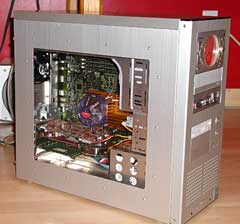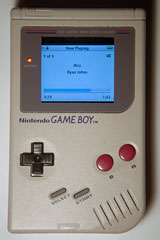As our Macs mature and get newer software, they can lose the ability
to perform even lightweight tasks with reasonable speed. Upgrading is
one way to improve their useful longevity, as I discussed in Know your Mac's Upgrade Options.
However, there is another method: Modification (or "modding") is the
practice of reengineering something to your own specifications.
Ambiguous as that definition might be, it really is as simple as
that. The viability of your ideas is the limit to what you can do.
Think of it as an art form: If there are things about your Mac that
you've wanted to change or perhaps just spice it up a bit, this is the
way to go.
I do realize the term's reputation. Your modded Mac doesn't have to
be painted in bright neon colors with lights hanging out of every
orifice in the case and be cooled by six thousand fans.
A good example of lightweight mods are sound enhancements. Some of
Apple's models (The Mirrored
Drive Door G4s, for example) came with quite loud power supply
fans. A 45 minute modification process (which is
well documented on Accelerate Your Mac), and the noise is
significantly lower.

If you're like me, you love the
aesthetics of some of your Macs. However, not all machines have the
power to maintain themselves for what you need. My favorite method for
solving this problem is building a faster Mac inside the vintage Mac's
case. For working examples of this process, check out my Twenty First Century Mac
and Charles
Mangin's "Marvin".

 It can be the
opposite: You may hate your Mac's case. (I'm sure there is somebody who
does.) Re-casing is also a popular mod for older desktops. Check out
the Silent ATX
G4 by Todd Anderson.
It can be the
opposite: You may hate your Mac's case. (I'm sure there is somebody who
does.) Re-casing is also a popular mod for older desktops. Check out
the Silent ATX
G4 by Todd Anderson.
Crippled machines make great mod projects. Have a laptop with a
cracked screen but don't have the heart to throw it out? Mod it, like
Richard Hunt did with his MacMidi. Being that the
machine is crippled, your mod's design must fit into certain guidelines
to get around the problem. You could easily end up turning an
inconvenient problem into a nifty feature.
If you're afraid to touch your expensive Mac Pro (or perfect
condition Classic) with a Dremel and screwdriver (I deeply sympathize),
I recommend starting with a cheap and easy machine. Wegener Media has
Blue & White G3
towers for $9.99 (no hard drive, no optical drive, add shipping). I
really don't think there is a better starter machine than the B&W G3. These will most
likely be the Rev. 1s, so keep that in mind when purchasing.
Having an inexpensive, expendable machine allows you to jump in with
more confidence. You will learn much quicker this way. Theodore
Roosevelt said it best: "One thing is sure. We have to do something. We
have to do the best we know how at the moment. If it doesn't turn out
right, we can modify it as we go along." You can always change your
plans if you encounter problems along the way.
As I recommended with system upgrades, it's best to do copious
amounts of research before beginning. Also, try writing or drawing your
ideas out on paper before exercising them.
 If you are looking for a starting
point or perhaps just want to take a look into some mods, I highly
recommend MacMod.com. They have a
multitude of guides to get started, as well as daily news in the
Macintosh modding community.
If you are looking for a starting
point or perhaps just want to take a look into some mods, I highly
recommend MacMod.com. They have a
multitude of guides to get started, as well as daily news in the
Macintosh modding community.
I just want to leave you with this last mod, the iBoy by sirljohns.
The iBoy is proof that mods are not limited to computers, so keep that
in mind.
On a closing note, if you love your Mac (old or new) in it's stock
form, shoot me an email and tell me why you wouldn't change anything
about it.
Good luck and happy modding! 



 It can be the
opposite: You may hate your Mac's case. (I'm sure there is somebody who
does.) Re-casing is also a popular mod for older desktops. Check out
the
It can be the
opposite: You may hate your Mac's case. (I'm sure there is somebody who
does.) Re-casing is also a popular mod for older desktops. Check out
the  If you are looking for a starting
point or perhaps just want to take a look into some mods, I highly
recommend
If you are looking for a starting
point or perhaps just want to take a look into some mods, I highly
recommend 
